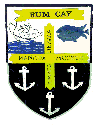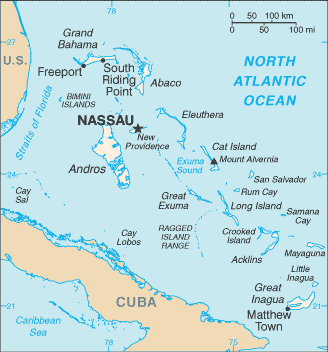Rum Cay


.svg.png)
Rum Cay (formerly known as Mamana and Santa Maria de la Concepción) is an island and district of the Bahamas. It measures 30 square miles in area, it is located at Lat.: N23 42' 30" - Long.: W 74 50' 00". It has many rolling hills that rise to about 120 feet (37 m). The island is believed to have acquired its modern name from a shipwrecked cargo of rum. The main settlement is Port Nelson. Its population was recorded as 53 in the 1990 census. Before 1996 the island was part of a combined district of San Salvador and Rum Cay.
Location
Rum Cay is 20 miles (32 km) southwest of San Salvador Island.
History
Aboriginals
Rum Cay was called Mamana by the native Lucayan Indians. In the north there is a cave containing Lucayan drawings and carvings. Various artifacts from the Arawak period have been found by farmers in the fertile soil, which the Indians enriched with bat guano.
Spanish
Rum Cay is believed to be the second island that Columbus visited in 1492, which he called Santa Maria de la Concepción. Spanish explorers once found a lone rum keg washed up on a shore and changed the name again to Rum Cay.
Loyalists
Plantation boundaries known as ‘margins’ can be seen all over the island, which date from the beginning of the 19th century when Loyalists settled here. In common with other islands, Rum Cay has gone through a series of industry specific economic peaks. Pineapple, salt and sisal have all been important industries, but competition and natural disasters, such as the 1926 hurricane, have all taken their toll. Settlements such as Port Boyd, Black Rock and Gin Hill are now deserted and overgrown.
Today
Tourism has traditionally been the main source of employment. Nearly everybody lives in Port Nelson where cottages can be rented. Important update and warning follows based on a visit in August 2013.
As of early 2013, the island's main marina - Summer Cay - closed for business and has no water, no ice, no electric, no supplies or other services available. Their website offers free dockage, but all other services are not available as offered. Most beach homes are shuttered and population is reportedly less than 30. Boats may still dock at no cost and the owners welcome guests as best they can. Entry into this marina is difficult for any sizeable boat, highly not recommended if drafting 6 feet or more, which is possible only during high tide. The channel is dangerously narrow and both the channel and marina entry require dredging. A visit during mid-tide in August 2013 required a pilot boat to guide an 83-foot yacht through the narrow channel into the marina, with intermittent areas of 4 foot depths. Boats have regularly caught the floating channel marker buoy wires in their props as they make a sharp turn in or out of the marina, a dangerous condition as the channel drops off to 3 feet or less very quickly.
Until the marina re-opens and the channel is dredged, Rum Cay should be a stop off only for the boating adventurous and those interested in fishing, otherwise it is not a viable stop.
Places of interest
Deep reefs and drop-offs surround this former pirates’ haven. There is staghorn coral at Summer Point Reef and diving at Pinder’s Point. At the Grand Canyon, 60-foot coral walls almost reach the surface. Sumner Point Marina has dockage, fuel, moorings, WiFi, bar and restaurant. NOTE: As of summer 2013, this marina is closed, and has only dockage available but absolutely no services. There is a small guesthouse available from former Constable Ted Bain. The Last Chance Yacht Supply has groceries. Batelco office for phone calls closes at lunchtime. Yachts wait here before sailing to Mayaguana or the Turks and Caicos Islands, or before returning to Georgetown and points north.
HMS Conqueror
The wreck of the 101-gun man of war HMS Conqueror, built in Devon in 1855 and which served in the Crimean War, lies in 30 feet of water off Rum Cay. She was lost on Sumner Point Reef, Rum Cay, on December 13, 1861. All 1,400 aboard survived. The wreck is preserved as the Underwater Museum of the Bahamas. It is the property of The Bahamas Government and none of the contents of the ship may be removed.
- "She was 20 nm out in estimating her position and, after making her landfall, cut rounding the southeast point of Rum Cay too fine and went hard on the reef. Her captain, fearing that his crew (most of whom could not swim in those days) would drink themselves insensible when it became obvious the ship was lost, ordered all ale, wine, and spirit casks to be broken and their contents ditched. He then sent the two largest ship’s company unloaded everything they could salvage, and set about making a camp on the island. The captain remained on board with one midshipman and ten seamen until the ship broke up. Then all of them, less the boat parties, were marooned on Rum Cay. They were rescued soon after the news of the disaster was known."
External links
| Wikivoyage has a travel guide for Rum Cay. |
| ||||||||||||||